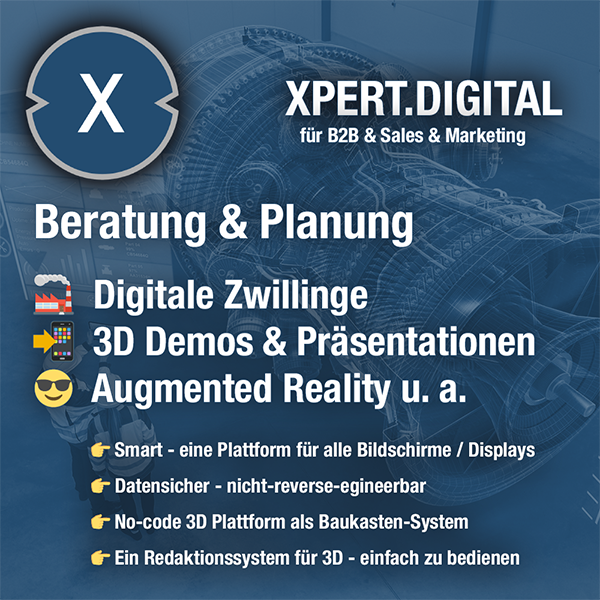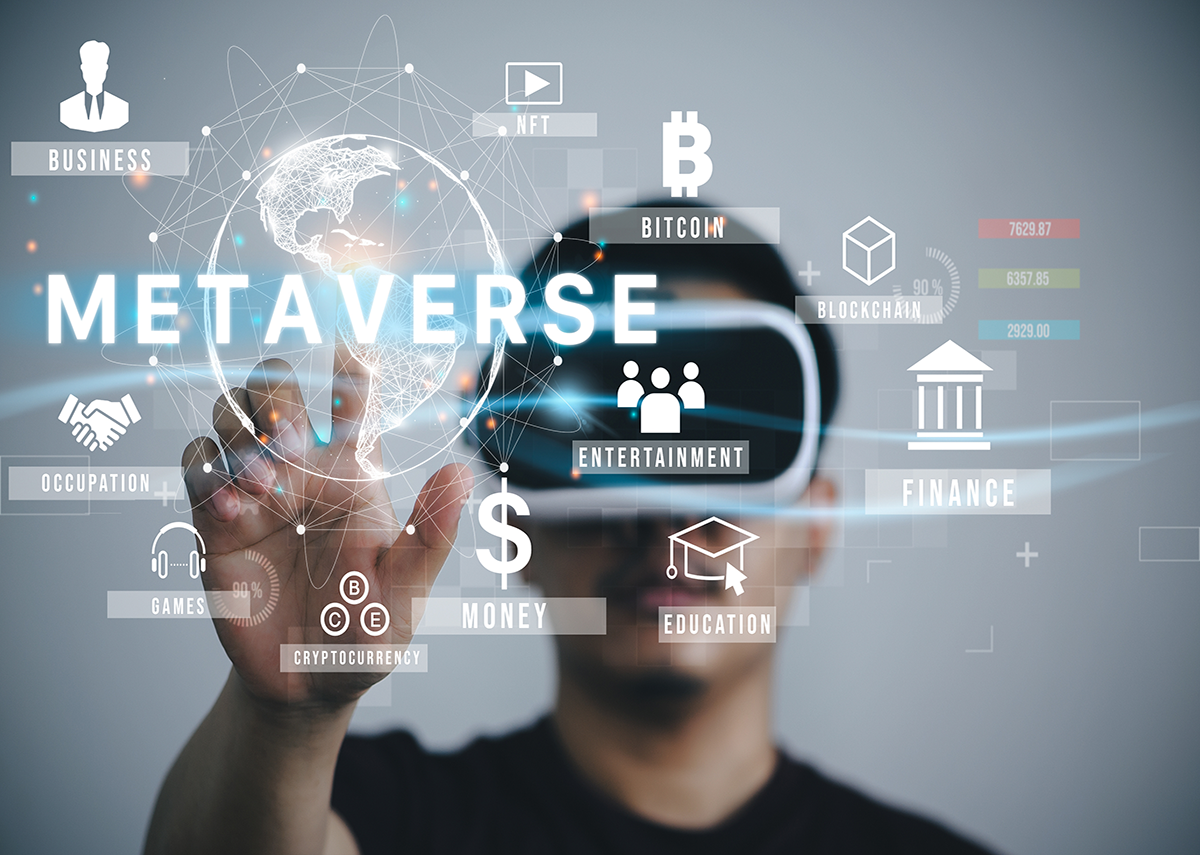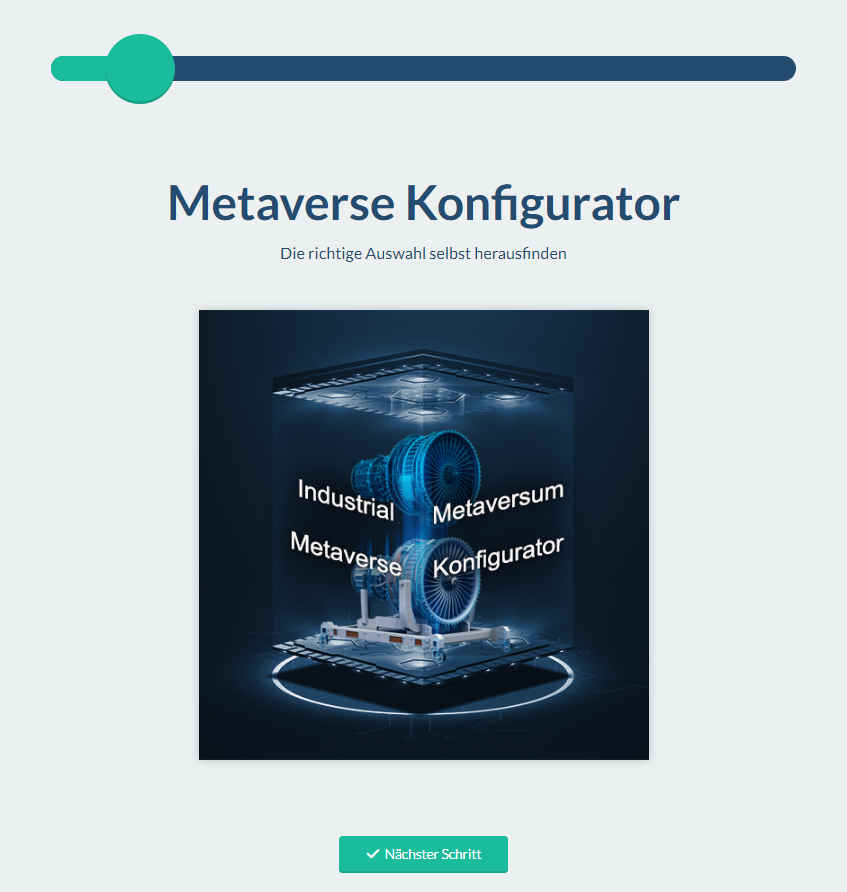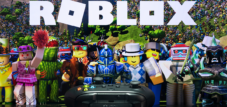(Consumer) Metaverse with blockchain technology – interoperability, proof of ownership, NFTs and virtual worlds
Language selection 📢
Published on: July 25, 2023 / update from: July 26, 2023 - Author: Konrad Wolfenstein
Metaverse with blockchain technology
The Metaverse is a highly debated concept with multiple interpretations. It is widely believed to revolutionize the Internet by presenting personalized avatars in a virtual world. But achieving truly transformative impact requires consistent protocols for seamless interaction, a universal currency, and a single login process. This is where blockchain technology comes into play to ensure decentralized consensus mechanisms, frictionless currency settlements, and authentication of ownership through NFTs. Interoperability and integration are critical to the success of the Metaverse in overcoming proprietary barriers. Although initial implementations already exist, the final form of the Metaverse will evolve over time based on feedback and global acceptance.
Blockchain for decentralized consensus
Blockchain technology plays an essential role in the Metaverse revolution. It enables a decentralized consensus mechanism in which no central authority or institution controls the transactions. Instead, transactions are confirmed by a network of computers, which are referred to as “nodes”. This creates a transparent, counterfeiting -proof and manipulation -proof system.
Smooth currency transactions
The Metaverse requires a universal currency that is accepted in all virtual worlds. Cryptocurrencies offer an ideal solution for this. Using cryptocurrencies in the metaverse allows users to seamlessly buy and sell goods and services within the virtual environment. The advantages of cryptocurrencies lie in their speed, low transaction costs and global acceptance.
Authenticating ownership through NFTs
NFTs (Non-Fungible Tokens) play a crucial role in authenticating ownership in the metaverse. NFTs are unique digital assets based on the blockchain that prove ownership of a specific digital asset or virtual piece of real estate. This allows users to provide their avatars, digital artwork or virtual real estate with clear proof of ownership.
Interoperability and integration
To realize the full potential of the metaverse, interoperability is essential. Different virtual worlds and platforms should be able to interact seamlessly with each other to ensure a consistent and cohesive experience for users. Open standards and interfaces are crucial to overcome proprietary barriers and facilitate integration.
Interoperability refers to the ability of different systems, platforms or technologies to seamlessly interact with each other and exchange information. In terms of the Metaverse revolution, interoperability means that different virtual worlds, platforms or applications in the Metaverse can communicate and cooperate with each other without encountering technical or content barriers.
High interoperability allows users to transfer their virtual avatars, digital assets or identities from one platform to another without being restricted by proprietary systems or closed standards. This creates a seamless and cohesive experience in the metaverse, increasing usability and enabling smooth switching between virtual worlds.
Interoperability is an important factor in the success of the Metaverse, as it expands the variety of virtual content and capabilities while improving the user experience. Open standards and interfaces play a critical role in promoting interoperability and helping the metaverse become an open and inclusive ecosystem where users can benefit from a wide range of options and innovations.
The evolution of the metaverse over time
Although the Metaverse is already seeing its first implementations, its final form has not yet been determined. The concept will evolve over time through user feedback and global adoption. New technologies and ideas will pave the way for innovative features and applications in the metaverse.
➡️ Investment Notice: We would like to point out that the information provided in this article does not constitute financial advice. Investing in cryptocurrencies and other investments associated with the Metaverse involves risks, and past results do not guarantee future profits.
➡️ The Metaverse promises an exciting future where the boundaries between the physical and virtual worlds will blur. Blockchain technology will play a central role in enabling decentralized consensus, frictionless currency settlements and proof of ownership. The Metaverse will continue to evolve and surprise us with new possibilities.
➡️ The Metaverse revolution is just beginning, and we are excited to see what exciting developments and possibilities the future will bring. The combination of blockchain technology, cryptocurrencies and virtual worlds promises a fascinating fusion of reality and virtuality. Be ready to be part of this exciting journey and explore the possibilities of the Metaverse!
Our Industrial Metaverse configurator
Just try out our universally applicable (B2B/Business/Industrial) Metaverse configurator for all CAD / 3D demo options:
Xpert (B2B/Business/Industrial) Metaverse configurator for all CAD / 3D data can be used on all devices, one platform!
Suitable for:
The fascination of the Metaverse: A look into the digital future with Decentraland
The concept of the metaverse has recently attracted a lot of attention, especially after the renovation of Facebook to “Meta”. But what exactly is behind this term? The metaverse is a virtual world that exists in a 3D room and is explored by users by avatars. It enables immersive experience and interactions that go far beyond the possibilities of conventional social media. Decentraland is a pioneer in creating such a digital future and has attracted companies through its demanding model.
Decentraland – A pioneering work in the consumer metaverse
Decentraland, as one of the leading Metaverse platforms, has captured the imagination of many people. Here, users can own virtual land and trade as non-fungible tokens (NFTs) on the Ethereum blockchain. The idea behind Decentraland is that users are not only participants in a virtual world, but also owners of land on which they can build, conduct business, or simply enjoy social interactions. The platform creates a decentralized environment designed by the community and offers limitless possibilities.
Metaverse and DeFi – A constantly growing market
The Metaverse is not only a place for virtual entertainment, but also a significant growth market in the blockchain sector. Along with the emerging DeFi sector, the Metaverse is expected to generate significant revenue in the coming years. Currently, the Metaverse market is valued at an impressive $2.5 billion. This illustrates the immense potential and attractiveness for companies and investors alike.
The Magic of Mana – Decentraland’s native cryptocurrency
The cryptocurrency “Mana” plays a central role in Decentraland. Mana is the native token of the platform and is used by the users to buy, sell and act virtual land. Mana has recently recorded a remarkable increase in value due to the increasing popularity of Decentraland. This shows that metavers and gaming applications make up a significant part of the NFT market and have a strong impact on cryptocurrency.
Metaverse – An integral part of the blockchain world
The Metaverse has firmly established itself in the world of blockchain and is much more than just a passing fad. With its combination of immersive experiences, decentralized design, and the ability to own digital property, the Metaverse will undoubtedly continue to capture people's attention. Decentraland has positioned itself as a pioneer and pioneer in this exciting development and will undoubtedly continue to play a central role in the future.
Outlook
The Metaverse offers an exciting prospect of the digital future with Decentraland. The combination of blockchain technology, NFTs and virtual reality opens up unprecedented possibilities for the way we interact, conduct business and express our creativity. The journey into the Metaverse has just begun, and Decentraland boldly leads us into this fascinating new world. We're excited to see what the future holds for the Metaverse and all of us.
DeFi sector - Decentralized Finance
The Defi sector stands for “Decentralized Finance” or in German “Decentralized Finance”. It is an innovative financial infrastructure based on blockchain technology that decentralized and digitized traditional financial services. In contrast to the conventional financial system, which is controlled by central institutions such as banks and stock exchanges, Defi gives users direct access to various financial products and services via decentralized platforms.
DeFi platforms are usually based on a public blockchain, such as Ethereum, and use so-called smart contracts, which are programmable contracts. These smart contracts enable the automated execution of financial operations without the need for a third-party provider or central authority. This bypasses most traditional financial intermediaries, resulting in lower costs, faster transactions and greater financial inclusion.
Various financial products and services can be found in the DeFi sector, including:
1. Lending
Users can take out or issue loans by depositing cryptocurrencies as collateral.
2. Liquidity pools
Users can contribute their cryptocurrencies to liquidity pools to use for lending and trading activities and earn interest in return.
3. Decentralized Exchanges (DEX)
Trading platforms where users can trade cryptocurrencies directly with each other, without a central authority acting as an intermediary.
4. Yield farming
Users can use various DeFi platforms to earn additional returns in the form of cryptocurrencies by providing liquidity and other financial activities.
5. Insurance
DeFi also offers the opportunity to purchase insurance products that cover certain risks and losses.
➡️ The DeFi sector has experienced tremendous growth and widespread adoption in recent years. The underlying technology and the diverse applications have the potential to fundamentally change the way we use financial services and complement or even revolutionize traditional financial systems. However, it is important to be aware that the DeFi sector also comes with risks, including high volatility and potential security vulnerabilities. Therefore, it is advisable to be fully informed and exercise caution before participating in DeFi activities.
Metaverse meets Blockchain: The appeal of virtual properties and their real meaning
The Metaverse is a fascinating concept that merges the virtual and real worlds in innovative ways. The Metaverse allows users to immerse themselves in a shared digital environment where they can meet, interact, transact, and engage in activities similar to those in a video game, but much more expansive and diverse. To support this unique digital ecosystem and manage the transactions that take place within it, blockchain technology is used.
The blockchain is a decentralized and transparent database consisting of a chain of blocks in which transactions are stored. Each block contains a cryptographic reference to the previous block, creating an immutable record. Blockchain technology therefore offers the ideal basis for the metaverse as it ensures security, trust and transparency.
A central aspect of the Metaverse is the purchase of virtual properties. These virtual properties are fictional, but nevertheless extremely sought-after and valuable goods within the digital world. Similar to real life, in this digital space you can secure a piece of land that acts as a virtual property. These properties can take various forms, from simple plots to elaborate virtual estates that serve as trading plazas, residential areas or entertainment centers.
Purchasing a virtual property in the Metaverse is usually done using digital currencies based on the blockchain. This is where cryptocurrency comes into play, allowing users to make actual transactions of value in the digital environment. Some of the most popular cryptocurrencies used in the Metaverse are Ethereum, which plays a crucial role with smart contracts, or other cryptos specifically designed for the Metaverse.
The value of these virtual properties is not just symbolic or fictitious. In fact, they can have significant monetary value. In some virtual worlds, there is a limited number of properties, which creates a shortage and drives up the price. Some sought-after properties have actually changed hands for large sums in the past, showing that the Metaverse real estate market can have a real and economic impact in the digital world.
Apart from the economic aspects, blockchain technology also plays a crucial role in data security and protecting user rights in the metaverse. Because blockchain is decentralized and immutable, data cannot be easily manipulated or deleted. This ensures a high level of trust, especially when it comes to protecting personal information or property rights.
The blockchain also enables virtual properties to be clearly and uniquely identifiable. This prevents properties from being sold or copied twice. Each property has a unique identifier linked to the owner and the digital assets on it.
In addition, blockchain opens up the possibility for virtual properties and digital assets to be easily transferred between different platforms and games. Interoperability between different Metaverse platforms is thus facilitated, increasing user-friendliness and expanding the overall Metaverse space.
➡️ Purchasing virtual properties in the Metaverse with blockchain technology is much more than just a fictitious value. It's an exciting new breed of digital good with real economic impact and potential. Blockchain technology supports the trading and security of these virtual properties, providing data security and protecting users' rights while providing the foundation for an expanded and interoperable metaverse. It is undoubtedly an exciting time to watch and participate in the development of this digital ecosystem.
Blockchain and Metaverse
Blockchain and Metaverse are two different concepts, but they can be related in some ways.
Blockchain is a decentralized and transparent technology used to record and verify transactions. It allows information to be stored in blocks that are chained together. Each block contains a cryptographic hash of the previous block, ensuring the integrity of the data. Blockchain is often used in the context of cryptocurrencies such as Bitcoin, but also has applications in many other areas such as supply chains, finance and decentralized applications (DApps).
The Metaverse, on the other hand, refers to a virtual, computer-based universe in which users can interact, create and experience content. It is often viewed as an augmented version of the Internet, merging physical and virtual reality. The Metaverse provides an immersive and interactive environment in which users can be represented by avatars and own digital currencies, digital assets and virtual items.
The connection between blockchain and the metaverse is that blockchain technology can provide a way to support the digital economy in the metaverse. By using blockchain, digital assets, virtual items and transactions in the metaverse can be made transparent, traceable and secure. Blockchain can also help verify ownership of digital content and prevent fraud.
Some projects and platforms are already combining blockchain and metaverse. For example, there are virtual worlds where users can buy, sell and trade digital properties using blockchain technology. These properties are represented on the blockchain as non-fungible tokens (NFTs). NFTs are unique digital assets that can represent ownership rights to specific objects or content.
The connection between blockchain and metaverse is expected to continue to grow in the future. With the increasing adoption of cryptocurrencies and interest in virtual worlds, the use of blockchain technology in the metaverse is likely to continue to grow. This could open up new opportunities for digital economies, social interactions and the creation of virtual ecosystems.
The stamp comparison
To explain Bitcoins and Ethereum using the postage stamp example, similarities and differences can be presented as follows:
Commonalities
- Limited availability: Both stamps and cryptocurrencies such as Bitcoin and Ethereum have a limited number of copies. For stamps, the circulation is determined by the amount printed, while for cryptocurrencies the maximum number of coins is determined by the protocol and underlying technology.
- Value: Both stamps and cryptocurrencies can have value. The value of stamps can be determined by their rarity, their historical or cultural background, and demand from collectors. With cryptocurrencies, value is determined by market demand and user trust in the technology and ecosystem.
differences
- Physical vs. Digital Nature: Stamps are physical objects that can be printed and collected. They can be touched, viewed and traded in the real world. In contrast, Bitcoin and Ethereum are purely digital currencies. They only exist in the form of data on a blockchain and cannot be physically traded or touched.
- Purpose: Stamps have primarily collector's value and are rarely used for transactions. They often represent historical events or cultural symbols. Cryptocurrencies such as Bitcoin and Ethereum, on the other hand, were developed as digital means of payment. They allow users to transfer value, conduct transactions, and enter into contracts online.
- Technology and Blockchain: The main difference between stamps and cryptocurrencies lies in the underlying technology. Cryptocurrencies like Bitcoin and Ethereum use a decentralized technology called blockchain that verifies and records transactions. Stamps, on the other hand, do not use such technology. They are therefore not forgery-proof. Detecting stamp counterfeits is difficult and requires the help of experts. Stamps do not provide currency security in the sense of being counterfeit-proof.
- Market price volatility: While the value of stamps is generally more stable and can rise or fall slowly (collectible value), cryptocurrencies can be subject to large price fluctuations. The cryptocurrency market is known for its high volatility, meaning that the prices of Bitcoin and Ethereum can rise or fall quickly and dramatically.
New territory for newbies: What you should know now about blockchain, tokens, NFTs, wallets, cryptocurrency and the metaverse
In today's digital world, terms such as blockchain, NFTs, wallets, cryptocurrencies and the metaverse have become increasingly present. For newcomers, these terms may seem confusing and complex at first. Here we try to explain these terms in an understandable way and give you important and interesting details about them.
More about it here:
Dekaverse: DekaBank is in the Metaverse – The Beta Metaverse – Decentraland, Marketing & Gamification
The Dekaverse serves as a kind of testing ground for DekaBank and its customers to explore new technologies and bring them closer to people. The focus here is primarily on blockchain technology, one of the most important innovations in digitalization.
In Decentraland, users have the opportunity to explore how the blockchain works and learn about cryptocurrencies and NFTs. This provides a unique opportunity for those new to these technologies to learn about them and expand their understanding of them.
More about it here:

Xpert.Digital – Pioneer Business Development
If you have any questions, further information or need advice on the topic of Consumer Metaverse or Metaverse in general, please feel free to contact me at any time.
I would be happy to serve as your personal advisor.
You can contact me by filling out the contact form below or simply call me on +49 89 89 674 804 (Munich) .
I'm looking forward to our joint project.
Xpert.Digital – Konrad Wolfenstein
Xpert.Digital is a hub for industry with a focus on digitalization, mechanical engineering, logistics/intralogistics and photovoltaics.
With our 360° business development solution, we support well-known companies from new business to after sales.
Market intelligence, smarketing, marketing automation, content development, PR, mail campaigns, personalized social media and lead nurturing are part of our digital tools.
You can find out more at: www.xpert.digital – www.xpert.solar – www.xpert.plus


































